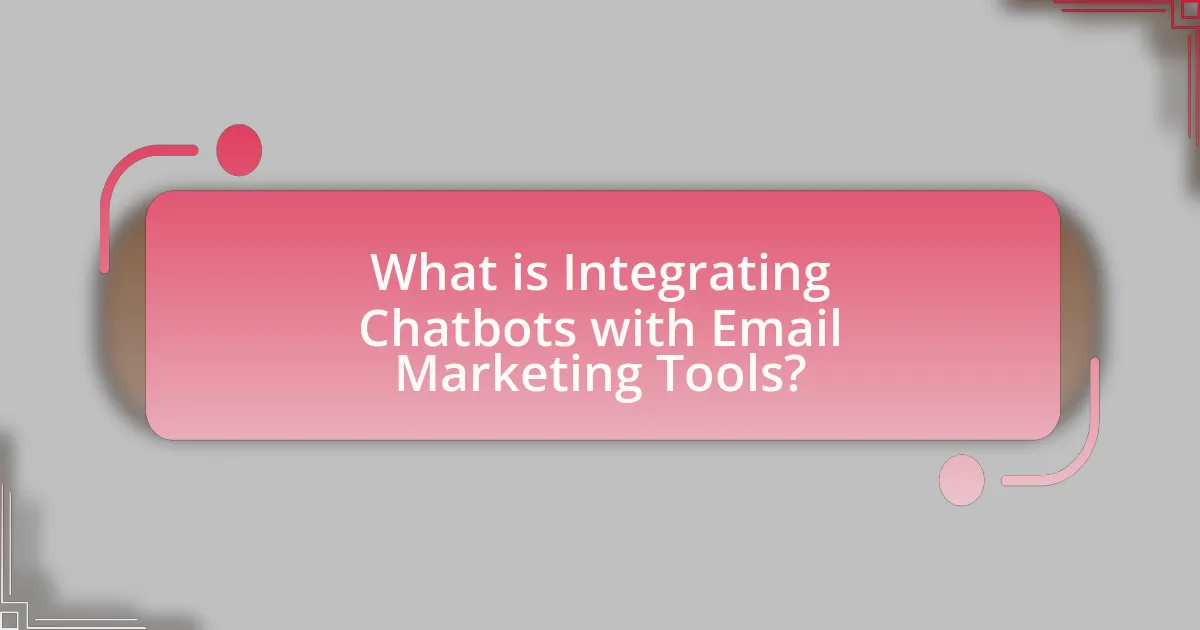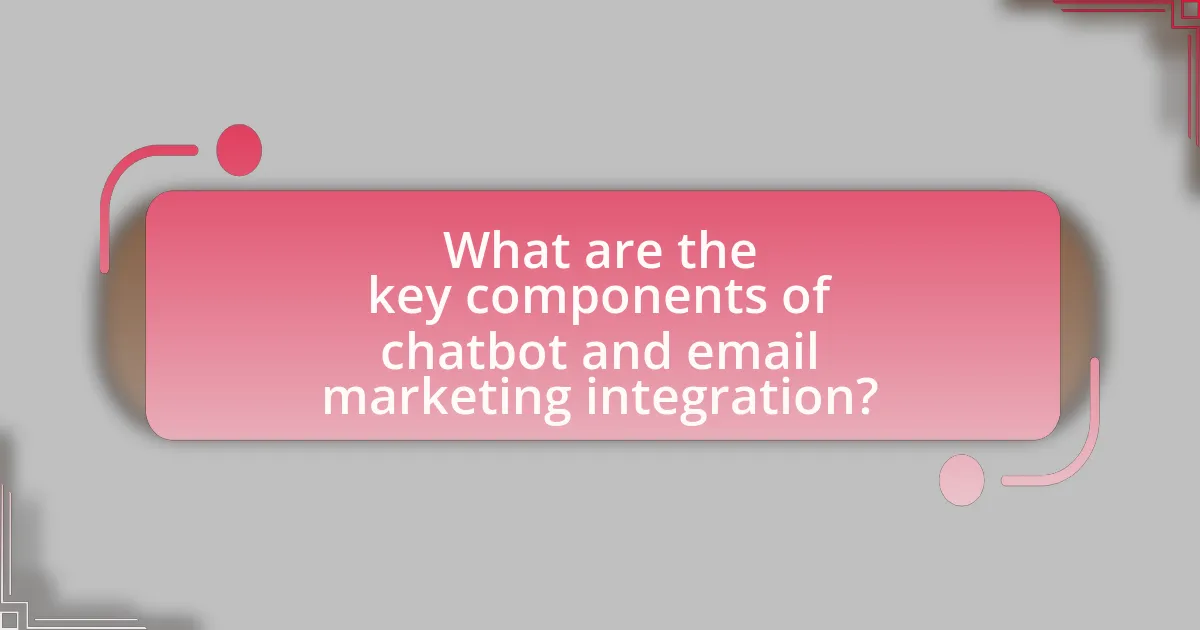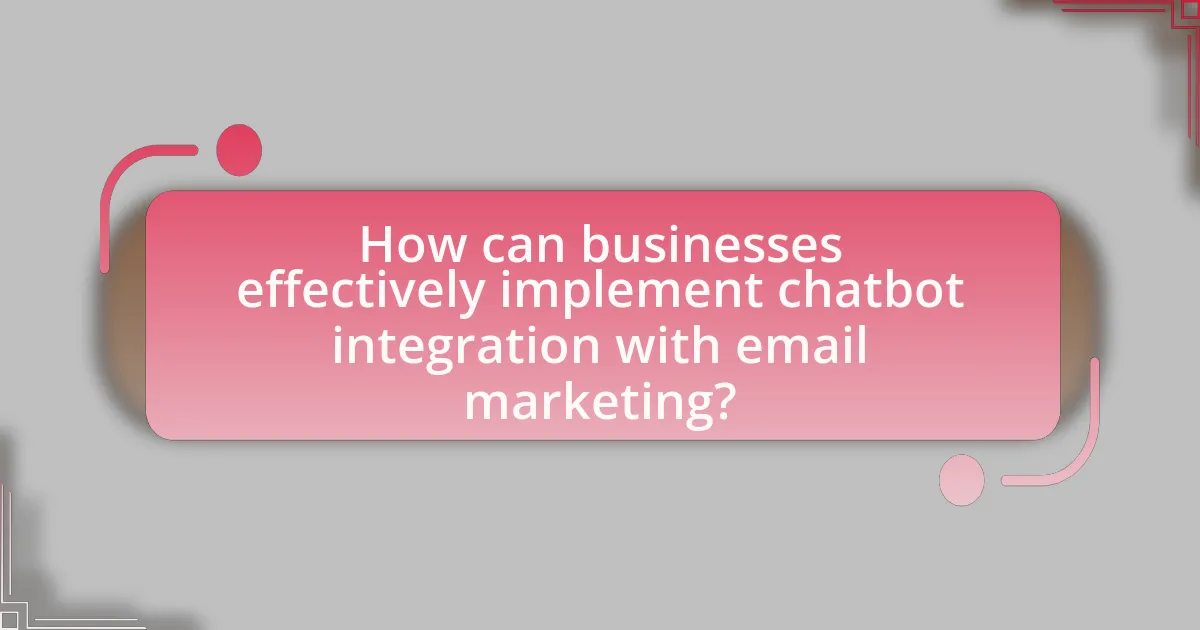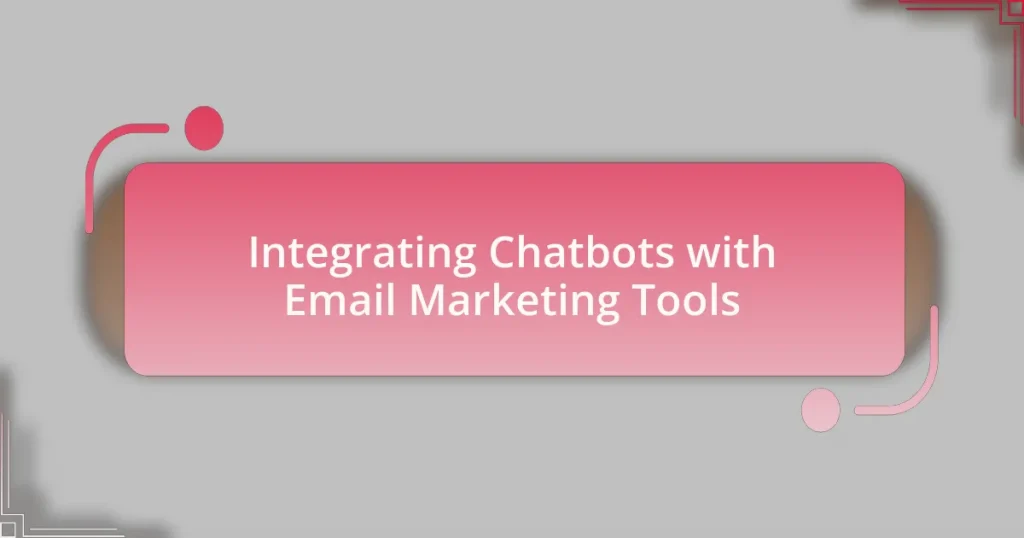Integrating chatbots with email marketing tools involves the use of automated conversational agents to enhance marketing campaigns through personalized interactions and automated responses. This integration allows businesses to collect customer data, improve engagement rates, and streamline communication processes. Key functionalities include automated responses, personalized content delivery, and lead qualification, which contribute to higher conversion rates and customer satisfaction. The article also discusses the importance of integration for operational efficiency, the challenges faced without it, and best practices for selecting and implementing chatbots alongside email marketing tools. Additionally, it highlights metrics for measuring success and strategies for optimizing the integration to enhance user experience.

What is Integrating Chatbots with Email Marketing Tools?
Integrating chatbots with email marketing tools involves the use of automated conversational agents to enhance email marketing campaigns. This integration allows businesses to engage with customers through personalized interactions, automate responses to inquiries, and streamline the process of collecting customer data. For instance, chatbots can gather user preferences and feedback directly from email interactions, which can then be used to tailor future marketing efforts. Studies show that companies utilizing chatbots in their email marketing strategies can increase customer engagement rates by up to 30%, demonstrating the effectiveness of this integration in driving better marketing outcomes.
How do chatbots enhance email marketing strategies?
Chatbots enhance email marketing strategies by automating customer interactions and personalizing communication. They can analyze user behavior and preferences, allowing marketers to send targeted emails that resonate with individual recipients. For instance, a study by HubSpot found that personalized emails can increase click-through rates by 14% and conversion rates by 10%. Additionally, chatbots can gather data from email interactions, providing insights that help refine future campaigns. This integration leads to improved customer engagement and higher return on investment for email marketing efforts.
What functionalities do chatbots provide in email marketing?
Chatbots provide several key functionalities in email marketing, including automated responses, personalized content delivery, and lead qualification. Automated responses enable chatbots to engage with customers instantly, addressing inquiries and providing information without human intervention. Personalized content delivery allows chatbots to analyze user behavior and preferences, tailoring email campaigns to individual recipients, which can increase engagement rates. Lead qualification is facilitated by chatbots through interactive conversations that gather information about potential customers, helping marketers identify high-quality leads for follow-up. These functionalities enhance the efficiency and effectiveness of email marketing strategies, ultimately driving better results for businesses.
How do chatbots improve customer engagement through email?
Chatbots improve customer engagement through email by providing personalized, timely responses to customer inquiries. This capability enhances the customer experience by ensuring that recipients receive relevant information and assistance based on their specific needs and behaviors. For instance, a study by HubSpot found that personalized emails can increase click-through rates by 14% and conversion rates by 10%. Additionally, chatbots can automate follow-up emails, ensuring that customers receive consistent communication without delays, which further fosters engagement and satisfaction.
Why is integration important for businesses?
Integration is important for businesses because it streamlines operations and enhances efficiency. By connecting various systems, such as chatbots with email marketing tools, businesses can automate processes, reduce manual errors, and improve customer engagement. For instance, a study by McKinsey found that companies that effectively integrate their digital tools can increase productivity by up to 20-30%. This integration allows for real-time data sharing, enabling personalized marketing strategies that can lead to higher conversion rates and customer satisfaction.
What challenges do businesses face without integration?
Businesses face significant challenges without integration, including data silos, inefficiencies in communication, and a lack of cohesive customer experiences. Data silos occur when information is isolated within different systems, leading to incomplete insights and hindered decision-making. Inefficiencies arise as teams may duplicate efforts or struggle to share information effectively, resulting in wasted resources and time. Additionally, without integration, customer interactions can become disjointed, negatively impacting customer satisfaction and loyalty. Research indicates that companies with integrated systems experience up to 20% higher productivity, highlighting the importance of seamless integration for operational success.
How does integration streamline marketing efforts?
Integration streamlines marketing efforts by enabling seamless communication and data sharing between chatbots and email marketing tools. This synergy allows for personalized customer interactions, as chatbots can gather user data and preferences in real-time, which can then be utilized to tailor email campaigns. For instance, a study by HubSpot found that personalized emails can increase click-through rates by 14% and conversion rates by 10%. By integrating these technologies, businesses can automate responses, segment audiences more effectively, and enhance overall customer engagement, leading to improved marketing efficiency and effectiveness.

What are the key components of chatbot and email marketing integration?
The key components of chatbot and email marketing integration include data synchronization, personalized messaging, automated workflows, and analytics tracking. Data synchronization allows chatbots to access and update customer information collected through email interactions, ensuring a seamless experience. Personalized messaging leverages user data to tailor communications, enhancing engagement and conversion rates. Automated workflows enable chatbots to trigger email campaigns based on user interactions, such as sending follow-up emails after a chat. Analytics tracking provides insights into user behavior and campaign performance, allowing marketers to optimize strategies effectively. These components work together to create a cohesive marketing strategy that enhances customer engagement and drives conversions.
What types of chatbots can be integrated with email marketing tools?
There are primarily two types of chatbots that can be integrated with email marketing tools: rule-based chatbots and AI-driven chatbots. Rule-based chatbots operate on predefined scripts and can handle specific queries, making them suitable for straightforward customer interactions. AI-driven chatbots utilize natural language processing and machine learning to understand and respond to a wider range of inquiries, providing a more personalized experience. The integration of these chatbots with email marketing tools enhances customer engagement by automating responses and facilitating targeted communication, ultimately improving conversion rates.
How do AI-driven chatbots differ from rule-based chatbots?
AI-driven chatbots utilize machine learning and natural language processing to understand and respond to user queries dynamically, while rule-based chatbots operate on predefined scripts and rules, limiting their responses to specific scenarios. AI-driven chatbots can learn from interactions, adapt to new inputs, and provide more personalized experiences, whereas rule-based chatbots can only respond based on the programmed rules, making them less flexible and capable of handling complex conversations. This distinction is crucial for businesses looking to enhance customer engagement through email marketing tools, as AI-driven chatbots can analyze user behavior and preferences to tailor interactions effectively.
What are the best practices for selecting a chatbot for integration?
The best practices for selecting a chatbot for integration include defining clear objectives, assessing compatibility with existing systems, evaluating user experience, and considering scalability. Defining clear objectives ensures that the chatbot meets specific business needs, such as customer support or lead generation. Assessing compatibility with existing systems, such as email marketing tools, guarantees seamless integration and data flow. Evaluating user experience involves testing the chatbot’s interface and functionality to ensure it is user-friendly and effective. Considering scalability is crucial for accommodating future growth and increased user interactions. These practices are supported by industry reports indicating that 70% of businesses that define clear objectives for chatbots see improved customer satisfaction and engagement.
What email marketing tools are commonly integrated with chatbots?
Email marketing tools commonly integrated with chatbots include Mailchimp, HubSpot, ActiveCampaign, and Sendinblue. These tools facilitate seamless communication between chatbots and email marketing campaigns, allowing for automated responses, personalized messaging, and efficient lead management. For instance, Mailchimp’s integration enables chatbots to capture email addresses and add them directly to mailing lists, enhancing user engagement and retention. HubSpot offers similar capabilities, allowing chatbots to trigger email workflows based on user interactions. ActiveCampaign and Sendinblue also provide robust integration options that streamline the process of nurturing leads through targeted email campaigns initiated by chatbot interactions.
Which features should be considered when choosing email marketing tools?
When choosing email marketing tools, key features to consider include automation capabilities, analytics and reporting, segmentation options, and integration with other platforms. Automation capabilities allow marketers to schedule and send emails based on user behavior, enhancing engagement. Analytics and reporting provide insights into open rates, click-through rates, and conversion metrics, enabling data-driven decisions. Segmentation options allow for targeted messaging to specific audience groups, improving relevance and effectiveness. Integration with other platforms, such as CRM systems and chatbots, ensures a seamless workflow and enhances overall marketing strategy. These features are essential for optimizing email marketing efforts and achieving better results.
How do popular email marketing platforms support chatbot integration?
Popular email marketing platforms support chatbot integration by providing APIs and built-in features that facilitate seamless communication between chatbots and email systems. For instance, platforms like Mailchimp and HubSpot allow users to connect chatbots to their email lists, enabling automated responses and personalized follow-ups based on user interactions. This integration enhances customer engagement by allowing chatbots to collect email addresses and trigger targeted email campaigns based on user behavior. Additionally, platforms often offer templates and workflows that simplify the setup process, ensuring that businesses can effectively utilize chatbot data to optimize their email marketing strategies.

How can businesses effectively implement chatbot integration with email marketing?
Businesses can effectively implement chatbot integration with email marketing by utilizing chatbots to collect user data and preferences, which can then be used to personalize email campaigns. This integration allows for real-time interaction, enabling chatbots to gather insights on customer behavior and preferences, which can enhance segmentation and targeting in email marketing. For instance, according to a study by HubSpot, personalized emails can generate up to six times higher transaction rates compared to non-personalized emails. By automating responses and gathering data through chatbots, businesses can streamline their email marketing efforts, ensuring that content is relevant and timely, ultimately improving engagement and conversion rates.
What steps are involved in the integration process?
The integration process of chatbots with email marketing tools involves several key steps. First, identify the specific email marketing tool that will be integrated with the chatbot, such as Mailchimp or Constant Contact. Next, configure the chatbot’s settings to connect with the chosen email marketing platform, which typically involves using API keys or webhooks provided by the email service. After establishing the connection, design the chatbot’s conversation flow to capture user information, such as email addresses and preferences, ensuring compliance with data protection regulations. Finally, test the integration to ensure that data is accurately transferred between the chatbot and the email marketing tool, allowing for effective communication and marketing automation.
How can businesses ensure a seamless integration experience?
Businesses can ensure a seamless integration experience by implementing standardized APIs and thorough testing protocols. Standardized APIs facilitate consistent communication between chatbots and email marketing tools, reducing compatibility issues. Additionally, conducting extensive testing before deployment allows businesses to identify and resolve potential integration challenges, ensuring that data flows smoothly and interactions are cohesive. Research indicates that companies utilizing standardized APIs experience a 30% reduction in integration time, leading to faster deployment and improved user satisfaction.
What common pitfalls should be avoided during integration?
Common pitfalls to avoid during integration of chatbots with email marketing tools include inadequate planning, lack of clear objectives, and insufficient testing. Inadequate planning can lead to misalignment between the chatbot’s capabilities and the email marketing goals, resulting in ineffective communication. Lack of clear objectives may cause confusion about the chatbot’s role, leading to poor user experience and low engagement rates. Insufficient testing can result in technical issues that disrupt the integration process, ultimately affecting the overall performance of both the chatbot and the email marketing tool. These pitfalls can hinder the effectiveness of the integration, making it crucial to address them proactively.
What metrics should be tracked to measure success?
To measure success in integrating chatbots with email marketing tools, key metrics include conversion rates, engagement rates, customer satisfaction scores, and response times. Conversion rates indicate the percentage of users who complete desired actions after interacting with the chatbot, reflecting its effectiveness in driving sales or leads. Engagement rates measure how actively users interact with the chatbot and email content, providing insights into user interest and content relevance. Customer satisfaction scores, often gathered through post-interaction surveys, assess user experience and satisfaction with the chatbot’s assistance. Response times track how quickly the chatbot responds to inquiries, impacting user satisfaction and retention. These metrics collectively provide a comprehensive view of the integration’s effectiveness and areas for improvement.
How can businesses analyze the effectiveness of chatbot interactions in emails?
Businesses can analyze the effectiveness of chatbot interactions in emails by tracking key performance indicators (KPIs) such as response rates, engagement metrics, and conversion rates. By utilizing analytics tools, businesses can measure how often recipients interact with chatbot prompts in emails, the duration of those interactions, and the outcomes, such as whether users complete desired actions like making a purchase or signing up for a newsletter. For instance, a study by HubSpot found that personalized email content, which can be enhanced by chatbot interactions, can increase click-through rates by up to 14%. This data allows businesses to assess the impact of chatbots on customer engagement and overall email marketing success.
What key performance indicators (KPIs) are relevant for integration success?
Key performance indicators (KPIs) relevant for integration success between chatbots and email marketing tools include conversion rates, customer engagement metrics, response times, and customer satisfaction scores. Conversion rates measure the percentage of users who complete desired actions, indicating the effectiveness of the integration in driving sales or leads. Customer engagement metrics, such as open rates and click-through rates, assess how well the chatbot and email campaigns resonate with the audience. Response times reflect the efficiency of the chatbot in addressing customer inquiries, while customer satisfaction scores gauge overall user experience. These KPIs provide a comprehensive view of the integration’s impact on business objectives and customer interactions.
What are the best practices for optimizing chatbot and email marketing integration?
The best practices for optimizing chatbot and email marketing integration include ensuring seamless data sharing, personalizing communication, and automating follow-ups. Seamless data sharing allows chatbots to collect user information and preferences, which can be utilized in email campaigns to enhance targeting. Personalizing communication increases engagement; for instance, using the user’s name and relevant content based on their interactions with the chatbot can significantly improve open rates. Automating follow-ups ensures timely responses to user inquiries, maintaining engagement and nurturing leads effectively. According to a study by HubSpot, personalized emails can deliver six times higher transaction rates, reinforcing the importance of these practices in achieving successful integration.
How can personalization enhance the effectiveness of the integration?
Personalization enhances the effectiveness of the integration between chatbots and email marketing tools by tailoring communication to individual user preferences and behaviors. This targeted approach increases engagement rates, as personalized messages are more likely to resonate with recipients. For instance, studies show that personalized emails can lead to a 26% increase in open rates and a 760% increase in revenue, demonstrating the significant impact of customization on user interaction and conversion. By leveraging data from chatbot interactions, marketers can create more relevant email content, thereby improving the overall effectiveness of their marketing strategies.
What strategies can improve user experience through integrated systems?
Integrating chatbots with email marketing tools can significantly improve user experience by providing personalized communication and timely responses. Personalization can be achieved through data integration, allowing chatbots to access user preferences and behaviors, which enables tailored messaging that resonates with individual users. Timely responses enhance user satisfaction by ensuring that inquiries are addressed promptly, reducing wait times and increasing engagement.
Research indicates that businesses utilizing integrated systems experience a 20% increase in customer satisfaction due to improved response times and personalized interactions. Furthermore, a study by HubSpot found that 70% of consumers prefer personalized experiences, highlighting the importance of integrating user data into communication strategies.










